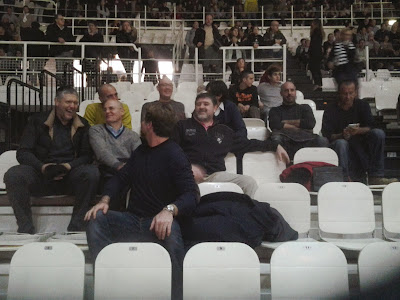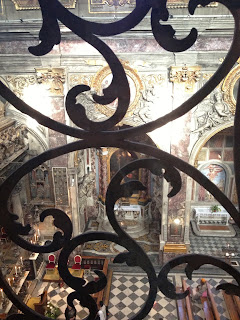The 1996
memoir by American author Frances Mayes Under the Tuscan Sun is the New York Times notable book of 1997 and New York
Times bestseller for more than two and a half years. The book has been
translated into 18 languages ‒ see the reviews at Goodreads ‒ and the film adaptation by Audrey Wells
(2003) was a box office success earning $43,610,723 domestically and a further
$15,268,000 internationally, totaling $58,878,723 worldwide (here you can find
the movie review Restoring a Villa While Repairing the Heart). All of this to say: the story has been read and seen by
many people all over the world (and especially in the US).
The book includes several chapters
of recipes, and this choice, is tightly connected to the quest
for the “authentic” Italian experience ‒ where food & wine are essentials
elements of the romantic approach I am trying to depict (see the post Under the Tuscan Sun: Staged Authenticity). But let’s go step by step.
Frances is a writer
unable to write; she isn’t sure what to do with her life after her divorce; she
is emotionally smashed. How (i.e. where) could she start a new life? Where can
she find new existential meanings? What place on earth will favor an emotional
rebirth? Where can she come across the contemporary version of the Sangre Reel,
a modest private balsam for the soul? The answer is simple: Italy (Tuscany, Florence),
of course. George Simmel interprets Florence precisely in the opposite way: the
perfect place for those who are in peace with themselves and with their lives,
either because they have achieved what they wanted or because they somehow
accepted their life as it is.
“The inner boundaries of Florence
are the boundaries of art. Florence is not a piece of earth on which to
prostrate oneself in order to feel the heartbeat of existence with its dark
warmth, its unformed strength, in the way that we can sense it in the forests
of Germany, at the ocean, and even in the flower gardens of some anonymous
small town. That is why Florence offers
us no foundation in epochs in which one might want to start all over again and
to encounter the sources of life once more, when one must orient oneself
within those confusions of the soul to an entirely original existence.
Florence is the good fortune of
those fully mature human beings who have
achieved or renounced what is essential in life, and who for this
possession or renunciation are seeking only its form” (Simmel 1906/2007, 41,
emphasis added).
Yet, the pathway to
Italy and Tuscany is readily available and well definite by centuries of storytelling. Patty, France’s best friend, gives to the
protagonist a ticket for a two-week tour of the Tuscany region ‒ I would not be
surprised to find an agency promoting a tour to Florence or Siena like this:
“Your emotional life is in pieces? No problem! Join the authentic Tuscan tour”.
Through a series of (apparently)
serendipitous events, France purchases a decaying villa in the Tuscan
countryside and ‒ the easy catching metaphor for the reconstruction her Self-identity
‒ decides to restore it. She has, of course, a romance with an Italian man ‒ Marcello ‒ however (obviously, as we will see in a moment) the story does not
last. And, again unsurprisingly, the protagonist sentimental itinerary ends ‒ after
having experienced the unfamiliar and unknown ‒ with a return back home.
Frances at the end of the story falls in love with an American man (who is also
a writer): the very familiar, both as belonging to a culture and to a class.
We can find more or less
the same protagonist characterization and plot in The Portrait of a Lady (Henry James; film adaptation by
Jane Campion, 1996) and in A Room with a View (E.M. Forster; film
adaptation by James Ivory, 1985). It is always about a
woman (American or English) in search for
her Self-identity. And the common theme to all these stories ‒ better, the Grand-Tour-Grand-Theme
with its articulations ‒ is a mere dichotomy: the New and the Old World. The
modern, rational, civilized, “cold” New World (United States or North Europe) versus the irrational, uncivilized but
passional and romantic Old World: Italy (Tuscany, Florence).
Florence and its
surrounding landscape ‒ Chianti region included, which is by the way just a
small portion of the very diverse Tuscany region ‒ are the idealized places
(better: settings or movie ‘locations’) for
the psychological/emotional travel toward the past, the roots of the
western civilization. It is in this never changing land that the traveler will
be able to find and freely express herself again, revitalizing the natural,
genuine, primary union with her human nature.
Florence (Italy) is the
place where everybody slows down and enjoys life, eating every day with the
extended family for six hours (three at lunch and three at dinner): all of my
students arrive here with this image and most of them bring it back home intact
‒ despites all of my attempts to deconstruct it or to enrich it. No need (no
need?) to say that this is a portrayal of a pre-modern, traditional Tuscany
(Italy) that does not exist and, by the way, never existed. No one with a minimal historical education (sense of
reality, if you prefer) can imagine an Italian peasant ‒ as any rustic in the
world ‒ having so much time and money to slow down and enjoy life. Any person
with some equilibrium between the pleasure principle
and the reality principle
(Freud 1911, 1920), can interpret the romantic traditional Italian image as topos in the tourist gaze.
Nevertheless, this
narrative about Italy written centuries ago has its strong hold upon the
foreigner experiences of Italy: this self-perpetuating myth becomes a
self-fulfilling prophecy.
“The self-fulfilling
prophecy is, in the beginning, a false definition of the
situation evoking a new behavior which makes the original false conception come
‘true’. This specious validity of the self-fulfilling prophecy perpetuates a
reign of error. For the prophet will cite the actual course of events as proof
that he was right from the very beginning” (Merton 1948, 195).
Hence, besides its
adherence to the social reality, this script is a fundamental framework to
understand foreigners’ experiences in Florence. It is the theorem of the
definition of the situation that we shall bring at the center of the
interpretation as the locus foci: “It
is not important whether or not the interpretation is correct… If men define
things as real, they are real in their consequences” (W.I. Thomas 1923). And
this foreigner Will to Believe (James 1956) is respectable as much as it is acceptable the local
controcanto (mine) Will to Doubt (Lloyd 1907). Although it
is not the objective of this post to analyze the relation between beliefs and
reality, we can point out how people have the tendency to reduce cognitive
dissonance by altering existing thoughts or adding new ones to create
consistency (Festinger 1956). Moreover, this romantic idea of Florence is
reinforced by touristic guides and the locals themselves, who are not the passive
receivers of such foreigners’ representations and projections; locals have a
different role but they are playing on the same stage: they make money out of
the romantic narrative.
-
Festinger,
L. (1957) A Theory of Cognitive
Dissonance. Stanford: University Press.
-
Freud, S. (1911) Formulations
regarding the two principles in mental functioning. Collected
papers, 4.
-
Freud,
S. (1920) Beyond the pleasure principle. SE,18.
-
James, W. (1956) The Will to Believe and Other
Essays in Popular Philosophy. New York: Dover.
-
Lloyd, A.H. (1907) The Will to Doubt: An Essay in
Philosophy for the General Thinker. London: Sonnenschein.
-
Merton,
R.K. (1948) The self-fulfilling prophecy. “The Antioch Review”, 8(2), 193-210.
-
Simmel, G. (1906) Florenz, in Der Tag, Erster Teil: Illustrierte Zeitung, 111
(Berlin). Eng. Trans. Florence, in
“Theory Culture Society”, 2007, 24: 38-41.

























.jpg)

